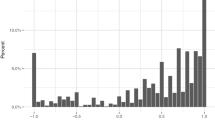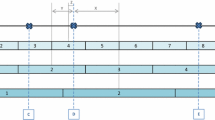Abstract
Background
Within the framework of economic evaluations, the transferability of utility scores between jurisdictions remains unclear. The EQ-5D is a generic instrument for measuring health-related quality of life in economic evaluations, which can be used for comparing utility scores across countries. At present, the EQ-5D has several national value sets or tariffs. Nevertheless, utility estimates from foreign studies are often used directly for cost-effectiveness estimates, without adapting by applying the appropriate national value set. It is unclear if this practice is advisable, due to dissimilarities between the national value sets.
Objective
To examine the effects of differences in national EQ-5D value sets on absolute and marginal utilities of health states, and determine to what degree these differences can be explained by methodological factors.
Methods
First, the relative importance of the EQ-5D domains for the utility estimates was compared across the 15 value sets. Second, two hypothetical health states for a depressed patient and a pain patient (21232 and 33321) were selected for additional analysis, by comparing the utilities as scored by the value sets. The marginal influence of a one-level deterioration in a domain of these health states on the utility estimate was then determined. Third, the differences between the value sets were examined in more detail by using multilevel analysis to examine the role of methodological differences in the valuation studies.
Results
Differences can be perceived between the national value sets of the EQ-5D in the preferences for the domains. The utilities of the two hypothetical health states show that the value sets differ substantially. Furthermore, the differences between the marginal values of the deteriorations are large, which can be explained partly by the type of valuation method. Other methodological differences also influence the value sets.
Conclusion
All results indicate that the differences between the EQ-5D value sets are considerable and should not be ignored. The differences can largely be explained by methodological differences in the valuation studies. The remaining differences may reflect cultural dissimilarities between countries. Therefore, further research should focus on investigating the transferability of utilities across countries or agreeing on a standard to perform valuation studies. For the time being, transferring utilities from one country to another without any adjustment is not advisable.
Similar content being viewed by others
References
Bryan S, Brown J. Extrapolation of cost-effectiveness information to local settings. J Health Serv Res Policy 1998; 3 (2): 108–12
Drummond MF, Sculpher MJ, Torrance GW, et al. Methods for the economic evaluation of health care programmes. 3rd ed. Oxford: Oxford University Press, 2005
Drummond MF, Pang F. Transferability of economic evaluation results. In: Drummond MF, McGuire A, editors. Economic evaluation in health care: merging theory with practice. Oxford: Oxford University Press, 2005: 256–76
Drummond M, Barbieri M, Cook J, et al. Transferability of economic evaluations across jurisdictions: ISPOR good research practices task force report. Value Health 2009; 12 (4): 409–18
Oostenbrink JB, Bouwmans CAM, Koopmanschap MA, et al. Handleiding voor kostenonderzoek. Methoden en standaard kostprijzen voor economische evaluaties in de gezondheidszorg. Diemen: College voor Zorgverzekeringen, 2004
Busschbach J, Weijnen T, Nieuwenhuizen M, et al. A comparison of EQ-5D time trade-off values obtained in Germany, the United Kingdom and Spain. In: Brooks R, Rabin R, de Charro F, editors. The measurement and valuation of health status using EQ-5D: a European perspective. Dordrecht: Kluwer Academic Publishers, 2003: 143–65
Badia X, Roset M, Herdman M, et al. A comparison of United Kingdom and Spanish general population time trade-off values for EQ-5D health states. Med Decis Making 2001; 21 (1): 7–16
Luo N, Johnson JA, Shaw J, et al. A comparison of EQ-5D index scores derived from the US and UK population-based scoring functions. Med Decis Making 2007; 27 (3): 321–6
Szende A, Oppe M, Devlin N. EQ-5D value sets: inventory, comparative review and user guide. Dordrecht: Springer, 2007
Levy AR, Kowdley KV, Iloeje U, et al. The impact of chronic hepatitis B on quality of life: a multinational study of utilities from infected and uninfected persons. Value Health 2008; 11 (3): 527–38
Brazier J, Deverill M, Green C, et al. A review of the use of health status measures in economic evaluation. Health Technol Assess 1999; 3 (9): 1–164
Dolan P. Modelling valuations for EuroQol health states. Med Care 1997; 35 (11): 1095–108
Noyes K, Dick AW, Holloway RG. The implications of using US-specific EQ-5D preference weights for cost-effectiveness evaluation. Med Decis Making 2007; 27 (3): 327–34
Mulligan J-A, Fox-Rushby J. Transferring cost-effectiveness data across space and time. In: Fox-Rushby J, Cairns J, editors. Economic evaluation. Maidenhead: Open University Press, 2005: 205–17
Brazier J, Ratcliffe J, Salomon JA, et al. Measuring and valuing health benefits for economic evaluation. Oxford: Oxford University Press, 2007
Wittrup-Jensen KU, Lauridsen JT, Gudex C, et al. Estimating Danish EQ-5D tariffs using the time trade-off (TTO) and visual analogue scale (VAS) methods. 18th Plenary meeting of the EuroQol group; 2001 Sep 6–7; Copenhagen
Greiner W, Claes C, Busschbach JJV, et al. Validating the EQ-5D with time trade off for the German population. Eur J Health Econ 2005; 6 (2): 124–30
Tsuchiya A, Ikeda S, Ikegami N, et al. Estimating an EQ-5D population value set: the case of Japan. Health Econ 2002; 11: 341–53
Lamers LM, McDonnell J, Stalmeier PFM, et al. The Dutch tariff: results and arguments for an effective design for national EQ-5D valuation studies. Health Econ 2006; 15: 1121–32
Jelsma J, Hansen K, de Weerdt W, et al. How do Zimbabweans value health states? Popul Health Metr 2003; 1(1): 11
Cleemput I. Economic evaluation in renal transplantation: outcome assessment and cost-utility of non-compliance. Leuven: Katholieke Universiteit Leuven, 2003
Greiner W, Weijnen T, Nieuwenhuizen M, et al. A single European currency for EQ-5D health states: results from a six-country study. Eur J Health Econ 2003; 4 (3): 222–31
Ohinmaa A, Eija H, Sintonen H. Modelling EuroQol values of the Finnish adult population. 12th plenary meeting of the EuroQol group; 1995 Oct 3–6; Barcelona
Ohinmaa A, Sintonen H. Inconsistencies and modelling of the Finnish EuroQol (EQ-5D) preference values. 15th plenary meeting of the EuroQol group; 1998 Oct 1–2; Hannover
Devlin NJ, Hansen P, Kind P, et al. Logical inconsistencies in survey respondents’ health state valuations: a methodological challenge for estimating social tariffs. Health Econ 2003; 12 (7): 529–44
Prevolnik Rupel V, Rebolj M. The Slovenian VAS tariff based on valuations of EQ-5D health states from the general population. 17th plenary meeting of the EuroQol group; 2000 Sep 28–29; Pamplona
Badia X, Roset M, Montserrat S, et al. The Spanish VAS tariff based on valuations of EQ-5D health states from the general population. 14th plenary meeting of the EuroQol group; 1997 Oct 2–3; Rotterdam
Marra CA, Woolcott JC, Kopec JA, et al. A comparison of generic indirect utility measures (the HUI2, HUI3, SF-6D, and the EQ-5D) and disease-specific instruments (the RA-Qol and the HAQ) in rheumatoid arthritis. Soc Sci Med 2005; 60 (7): 1571–82
Rasbash J, Steele F, Browne W, et al. A user’s guide to Mlwin, version 2. Bristol: University of Bristol, 2005
Altman DG. Practical statistics for medical research. Boca Raton (FL): Chapman & Hall, 1999
Wolfs CAG, Dirksen CD, Kessels A, et al. Economic evaluation of an integrated diagnostic approach for psychogeriatric patients: results of a randomised controlled trial. Arch Gen Psychiatry 2009; 66 (3): 313–23
Author information
Authors and Affiliations
Corresponding author
Rights and permissions
About this article
Cite this article
Knies, S., Evers, S.M.A.A., Candel, M.J.J.M. et al. Utilities of the EQ-5D. Pharmacoeconomics 27, 767–779 (2009). https://doi.org/10.2165/11314120-000000000-00000
Published:
Issue Date:
DOI: https://doi.org/10.2165/11314120-000000000-00000




